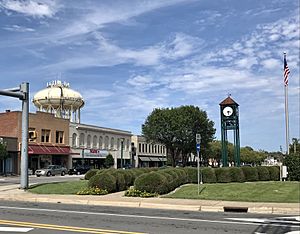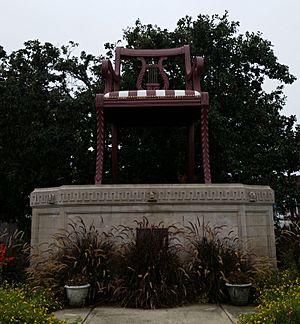Thomasville, North Carolina facts for kids
Quick facts for kids
Thomasville, North Carolina
|
||
|---|---|---|
 |
||
|
||
| Nickname(s):
T-Ville, T-Vegas, Chair City, Tater Town
|
||

Location in Davidson County and the state of North Carolina
|
||
| Country | United States | |
| State | North Carolina | |
| Counties | Davidson, Randolph | |
| Incorporated | 1857 | |
| Area | ||
| • Total | 16.78 sq mi (43.47 km2) | |
| • Land | 16.77 sq mi (43.43 km2) | |
| • Water | 0.01 sq mi (0.03 km2) | |
| Elevation | 827 ft (252 m) | |
| Population
(2020)
|
||
| • Total | 27,183 | |
| • Density | 1,621.03/sq mi (625.89/km2) | |
| Time zone | UTC−5 (EST) | |
| • Summer (DST) | UTC−4 (EDT) | |
| ZIP codes |
27360-27361
|
|
| Area code(s) | 336 | |
| FIPS code | 37-67420 | |
| GNIS feature ID | 2405585 | |
Thomasville is a city in Davidson County, North Carolina, USA. About 27,183 people lived there in 2020. It was once famous for making furniture, just like nearby High Point and Lexington. This city in the Piedmont Triad area started in 1852. It's home to North Carolina's oldest festival, called "Everybody's Day".
Contents
History of Thomasville
John Warwick Thomas was born in 1800. By the time he was 22, he owned a lot of land. He became a state representative and later a state senator. John Thomas worked hard to get a railroad built through Davidson County. He even invested his own money in the project.
Knowing the railroad was coming, Thomas built the first store in the area in 1852. This is how the community of Thomasville got its name. In 1855, the North Carolina Railroad reached Thomasville. On January 8, 1857, Thomasville officially became a town. It covered one square mile, with the railroad running through the middle.
In 1860, Thomasville had 308 people. After the American Civil War, the population dropped to 217. But by 1880, it grew to 450 people, and by 1890, there were 751 residents.
Furniture Making in Thomasville
Furniture making started small in Thomasville. Long Bill Whiteheart made chairs at home. D.S. Westmoreland also made chairs at home starting in 1866. His factory opened in 1879 but burned down later. The oldest furniture factory still standing in 1990 was Standard Chair, built in 1898. Other early furniture companies included Lambeth Furniture and Queen Chair Company.
Cramer Furniture was a very large furniture company in the South by 1901. Thomasville Chair, which started in 1904, quickly became the town's biggest furniture maker. By 1916, Thomasville was producing 2,000 chairs every day!
Other Industries and Historic Sites
By 1909, Thomasville also became known for making textiles, with Jewel Cotton Mills and Amazon Cotton Mills. Later, hosiery (sock) factories like Sellers Hosiery Mills and Thomasville Hosiery opened.
Many places in Thomasville are listed on the National Register of Historic Places. These include old churches, inns, schools, and homes. Some examples are the Abbott's Creek Primitive Baptist Church Cemetery and the Thomasville Railroad Passenger Depot.
The Big Chair Landmark

Thomasville is often called the "Chair Town" or "Chair City." This is because of a giant chair landmark in the middle of the city. It's a 30-foot-tall replica of a Duncan Phyfe armchair.
The first "Big Chair" was built in 1922 by the Thomasville Chair Company. It was made of wood and steer hide to show off the city's furniture industry. However, this chair was taken down in 1936 because of weather damage.
In 1951, a new, bigger concrete version of the chair was built. Local businesses and groups helped create it. This concrete chair is still there today. The Big Chair became famous in 1960 when Lyndon B. Johnson, who was running for president, greeted people from it during a campaign stop. Even though some bigger chairs have been built elsewhere, many Thomasville residents still proudly say their Big Chair is the "World's Largest Chair."
Geography and Climate
Thomasville is in the northeast part of Davidson County. To its east is the city of Trinity in Randolph County.
The city of Thomasville covers about 43.5 square kilometers (16.8 square miles). Only a very small part of this area is water.
Thomasville Weather
Thomasville has a climate with warm summers and mild winters.
| Climate data for Thomasville, North Carolina | |||||||||||||
|---|---|---|---|---|---|---|---|---|---|---|---|---|---|
| Month | Jan | Feb | Mar | Apr | May | Jun | Jul | Aug | Sep | Oct | Nov | Dec | Year |
| Record high °F (°C) | 83 (28) |
85 (29) |
90 (32) |
96 (36) |
100 (38) |
105 (41) |
105 (41) |
105 (41) |
104 (40) |
94 (34) |
89 (32) |
80 (27) |
105 (41) |
| Mean daily maximum °F (°C) | 51 (11) |
56 (13) |
64 (18) |
74 (23) |
80 (27) |
87 (31) |
90 (32) |
88 (31) |
82 (28) |
73 (23) |
63 (17) |
53 (12) |
72 (22) |
| Daily mean °F (°C) | 41 (5) |
45 (7) |
52 (11) |
61 (16) |
68 (20) |
76 (24) |
79 (26) |
78 (26) |
72 (22) |
61 (16) |
52 (11) |
43 (6) |
61 (16) |
| Mean daily minimum °F (°C) | 30 (−1) |
33 (1) |
39 (4) |
48 (9) |
56 (13) |
65 (18) |
68 (20) |
68 (20) |
61 (16) |
49 (9) |
41 (5) |
33 (1) |
49 (10) |
| Record low °F (°C) | −7 (−22) |
−2 (−19) |
7 (−14) |
22 (−6) |
25 (−4) |
39 (4) |
47 (8) |
41 (5) |
34 (1) |
19 (−7) |
10 (−12) |
0 (−18) |
−7 (−22) |
| Average precipitation inches (mm) | 3.69 (94) |
3.80 (97) |
4.12 (105) |
3.90 (99) |
3.47 (88) |
4.04 (103) |
4.52 (115) |
4.43 (113) |
4.07 (103) |
3.36 (85) |
3.41 (87) |
3.43 (87) |
46.24 (1,176) |
| Source: The Weather Channel | |||||||||||||
Population and People
| Historical population | |||
|---|---|---|---|
| Census | Pop. | %± | |
| 1860 | 308 | — | |
| 1870 | 214 | −30.5% | |
| 1880 | 450 | 110.3% | |
| 1890 | 590 | 31.1% | |
| 1900 | 751 | 27.3% | |
| 1910 | 3,877 | 416.2% | |
| 1920 | 5,676 | 46.4% | |
| 1930 | 10,090 | 77.8% | |
| 1940 | 11,041 | 9.4% | |
| 1950 | 11,154 | 1.0% | |
| 1960 | 15,190 | 36.2% | |
| 1970 | 15,230 | 0.3% | |
| 1980 | 14,144 | −7.1% | |
| 1990 | 15,915 | 12.5% | |
| 2000 | 19,788 | 24.3% | |
| 2010 | 26,757 | 35.2% | |
| 2020 | 27,183 | 1.6% | |
| 2022 (est.) | 27,399 | 2.4% | |
| U.S. Decennial Census | |||
Thomasville has grown a lot over the years. In 2020, there were 27,183 people living in the city. The city had 11,190 households and 6,789 families.
Diversity in Thomasville
Thomasville is a diverse city. The 2020 United States census showed the following groups:
| Race | Number | Percentage |
|---|---|---|
| White (non-Hispanic) | 15,461 | 56.88% |
| Black or African American (non-Hispanic) | 5,481 | 20.16% |
| Native American | 124 | 0.46% |
| Asian | 396 | 1.46% |
| Pacific Islander | 8 | 0.03% |
| Other/Mixed | 1,176 | 4.33% |
| Hispanic or Latino | 4,537 | 16.69% |
In 2010, about 32.2% of households had children under 18. The average household had 2.50 people. The average family had 3.05 people. The median age in the city was 36.2 years. This means half the people were younger than 36.2, and half were older.
The median income for a household in Thomasville was $34,253. For a family, it was $40,795. About 29.2% of the people in Thomasville lived below the poverty line. This included 45.1% of children under 18.
Economy and Businesses
Thomasville has a long history with furniture making. The name "Thomasville" is often used for high-quality furniture. Thomasville Furniture Industries started here in 1904. It began as a chair company and grew into a large furniture manufacturer. The last two furniture plants in Thomasville closed in 2014. Now, the company's showroom in Thomasville is also closed. However, the company still has a plant in Lenoir, North Carolina.
Other important companies in Thomasville include:
- Mohawk Industries, a flooring company.
- Old Dominion Freight Line, a trucking company.
- Cook Out, a popular restaurant chain.
Education in Thomasville
Thomasville has its own public school system, called Thomasville City Schools. It has four schools:
- Thomasville Primary (Kindergarten to 3rd grade)
- Liberty Drive Elementary (4th to 5th grade)
- Thomasville Middle School (6th to 8th grade)
- Thomasville High School (9th to 12th grade)
The Davidson County Schools system also has schools in the Thomasville area. These include several elementary schools, two middle schools, and two high schools:
- East Davidson High School (9th to 12th grade)
- Ledford High School (9th to 12th grade)
Local Sports Teams
Thomasville is proud of its sports teams.
Thomasville Senior High Bulldogs
The Thomasville Senior High School Bulldogs are very successful in sports. They are especially known for their football team.
- The Bulldogs won the state 1AA Football Championship in 2004, 2005, 2006, and 2008.
- The 1995 Bulldogs football team was the first in North Carolina history to have a perfect 16-0 season.
- In 2005, Thomasville High was the first school in North Carolina to win state championships in football, women's basketball, men's basketball, and men's soccer all in the same year!
Championships Won
| Award | Years |
|---|---|
| Football State Champions | 1964, 1988, 1991, 1995, 2004, 2005, 2006, 2008 |
| Basketball State Champions (Men's) | 1998, 2000, 2003, 2005, 2007 |
| Basketball State Champions (Women's) | 2002, 2003, 2004, 2005 |
| Wrestling State Champions | 1960, 1961, 1962, 1973, 1991 |
| Soccer State Champions (Men's) | 2005 |
The Thomasville Senior High School also has a marching band called The Scarlet Regiment. In 2008, they placed fifth in a national band competition.
High Point-Thomasville HiToms Baseball
Thomasville is home to the High Point-Thomasville HiToms baseball team. They play in the Coastal Plain League, which is a summer league for college baseball players. The HiToms won the league championship (the Petitt Cup) in 2006, 2007, and 2008.
The HiToms play at Historic Finch Field in Thomasville. This baseball field was built in 1935. Many famous baseball players, like Hall of Famer Eddie Mathews, played at Finch Field when it was home to minor league teams from 1937 to 1969.
Local News and Media
Thomasville has its own local newspaper, The Thomasville Times. It comes out every two weeks and covers news about the city. Larger daily newspapers from nearby cities also cover Thomasville news. These include:
- The Winston-Salem Journal
- The High Point Enterprise
- The Greensboro News & Record
Famous People from Thomasville
Many notable people have come from Thomasville, including:
- Johnny Allen, a professional baseball pitcher.
- Akeem Davis-Gaither, an NFL linebacker.
- Brad Hoover, an NFL fullback.
- Wil Myers, a professional baseball player.
- Brian Vickers, a NASCAR race car driver.
- Kariamu Welsh, a famous dance choreographer and scholar.
See also
 In Spanish: Thomasville (Carolina del Norte) para niños
In Spanish: Thomasville (Carolina del Norte) para niños



